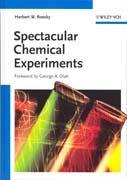Herbert W. Roesky
Weinheim: Wiley-VCH 2007 | Pp224 | £22.50 | ISBN 978 3 52 731865 0
Reviewed by Adrian Guy

Aimed at teachers and technicians, Spectacular chemical experiments contains over 80 experiments in no particular order. The experiments vary from those suitable for impressive demonstrations to interesting chemical reactions which present lovely chemistry and colourful reactions.
As always with this genre of book, the reader would need to be a real enthusiast of chemical demonstrations and have a passion for experimentation because many of these reactions require time and considerable preparation to reproduce in the classroom.
Each experiment is presented in a standard, clear and easily readable template - apparatus, chemicals, safety, procedure and explanation. Occasionally, photographs of the set-up or resulting reactions are included, but this is not the norm and a real shame because the photographs do improve the readability and appeal of the experiments.
I feel the book is inappropriately named because only some of the experiments are spectacular, though others could be if the methods were scaled up or altered to make the reaction more visible to a larger audience. This is not to say, however, they are not interesting or would not make great experiments to perform as class practicals or demonstrations to spice up lessons or lectures.
Within the book there are some highly original and fascinating ideas that could help to captivate a class or prove a starting point for a school chemistry club where pupils could do some of the experiments as safe project work in conjunction with their teacher. I particularly liked experiment 17, Magic eggs, where an egg moves up and down in a hydrochloric acid solution as a result of carbon dioxide bubbles forming on the carbonate shell.
To increase appeal and sound more interesting, the author has re-branded some of the experiments with nonsensical names that offer no information about their content. For example experiment 81, Icarus and the sun, is a great experiment in which the black pigment in pen ink is used to absorb focused sunlight to ignite paper impregnated with potassium nitrate. But, while the title makes perfect sense once the experiment has been studied, it makes no sense when scanning the contents. This is a shame because with more factual titles the indexing would be more useful.
Nowadays, the Internet is a prolific source of information and often the first port of call for a demonstrator looking for new ideas. As such details on many of the better demonstrations and experiments contained in this book can be found in this way. For me and my colleagues - all experienced demonstrators - if we had money to spend on books, we agreed that it would be better spent on one of the books in the series Chemical demonstrations: a handbook for teachers of chemistry by B. Z. Shakhashiri.






No comments yet